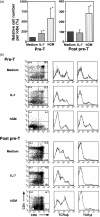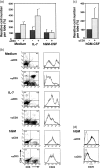Interleukin-7 inhibits pre-T-cell differentiation induced by the pre-T-cell receptor signal and the effect is mimicked by hGM-CSF in hGM-CSF receptor transgenic mice
- PMID: 12047750
- PMCID: PMC1782720
- DOI: 10.1046/j.1365-2567.2002.01402.x
Interleukin-7 inhibits pre-T-cell differentiation induced by the pre-T-cell receptor signal and the effect is mimicked by hGM-CSF in hGM-CSF receptor transgenic mice
Abstract
We have previously reported that human granulocyte-macrophage colony-stimulating factor (hGM-CSF) causes a stage-specific inhibition of T-cell receptor (TCR) alphabeta cell development in the thymus of transgenic mice constitutively expressing the hGM-CSF receptor. Since it has been reported that the addition of interleukin-7 (IL-7) to fetal thymic organ culture (FTOC) has similar effects, we compared the effects of IL-7 and hGM-CSF on TCR(alphabeta) cell development in hGM-CSF receptor transgenic mice. We reconstituted fetal lobes with sorted pre-T, or post pre-T CD4(-)CD8(-) precursor cells. The addition of either IL-7 or hGM-CSF to these cultures suppressed further differentiation of pre-T cells but not post pre-T cells. At the same time, the cell number was increased, suggesting that pre-T-cell proliferation is stimulated by these cytokines. Furthermore, the differentiation of recombination-activating gene-1 (RAG-1)-deficient pre-T cells in response to anti-CD3 antibody stimulation was suppressed by either IL-7 or hGM-CSF, suggesting that these cytokines inhibit the pre-T-cell receptor (pre-TCR) signal. This inhibition is unexpected because the pre-TCR signal and the IL-7 signal have previously been considered to be co-operative. Recent analysis of the downstream events of IL-7 receptor and GM-CSF receptor revealed that they share common signal transduction molecules. Our results show that IL-7 is able to promote pre-T cell proliferation and to suppress differentiation induced by the pre-TCR signal. GM-CSF can mimic these biological activities of IL-7 when the pre-T cells express GM-CSF receptors. Our data suggest that both timing and level of activation of the IL-7 signalling pathway must be precisely regulated to facilitate the differentiation of thymocytes.
Figures




Similar articles
-
Thymocyte proliferation and differentiation in human granulocyte-macrophage colony-stimulating factor receptor transgenic mice.J Allergy Clin Immunol. 1997 Dec;100(6 Pt 2):S87-96. doi: 10.1016/s0091-6749(97)70012-5. J Allergy Clin Immunol. 1997. PMID: 9440552
-
Human granulocyte-macrophage colony-stimulating factor (hGM-CSF) induces inhibition of intrathymic T-cell development in hGM-CSF receptor transgenic mice.Blood. 1997 Feb 15;89(4):1349-56. Blood. 1997. PMID: 9028958
-
Human granulocyte-macrophage colony-stimulating factor (hGM-CSF)-dependent in vitro and in vivo proliferation and differentiation of all hematopoietic progenitor cells in hGM-CSF receptor transgenic mice.J Allergy Clin Immunol. 1997 Dec;100(6 Pt 2):S79-86. doi: 10.1016/s0091-6749(97)70011-3. J Allergy Clin Immunol. 1997. PMID: 9440551
-
Roles of JAK kinases in human GM-CSF receptor signal transduction.J Allergy Clin Immunol. 1996 Dec;98(6 Pt 2):S183-91. doi: 10.1016/s0091-6749(96)70065-9. J Allergy Clin Immunol. 1996. PMID: 8977526 Review.
-
Fidelity and infidelity in commitment to B-lymphocyte lineage development.Immunol Rev. 2000 Jun;175:104-11. Immunol Rev. 2000. PMID: 10933595 Review.
Cited by
-
Synergistic effects of interleukin-7 and pre-T cell receptor signaling in human T cell development.J Biol Chem. 2012 Sep 28;287(40):33826-35. doi: 10.1074/jbc.M112.380113. Epub 2012 Aug 2. J Biol Chem. 2012. PMID: 22859301 Free PMC article.
-
Progression of regulatory gene expression states in fetal and adult pro-T-cell development.Immunol Rev. 2006 Feb;209:212-36. doi: 10.1111/j.0105-2896.2006.00355.x. Immunol Rev. 2006. PMID: 16448545 Free PMC article. Review.
-
RANKL stimulates proliferation, adhesion and IL-7 expression of thymic epithelial cells.Exp Mol Med. 2008 Feb 29;40(1):59-70. doi: 10.3858/emm.2008.40.1.59. Exp Mol Med. 2008. PMID: 18305399 Free PMC article.
-
Sustained expression of pre-TCR induced beta-catenin in post-beta-selection thymocytes blocks T cell development.J Immunol. 2009 Jan 15;182(2):759-65. doi: 10.4049/jimmunol.182.2.759. J Immunol. 2009. PMID: 19124718 Free PMC article.
-
Impaired thymopoiesis in interleukin-7 receptor transgenic mice is not corrected by Bcl-2.Cell Immunol. 2007 Nov-Dec;250(1-2):31-9. doi: 10.1016/j.cellimm.2008.01.002. Epub 2008 Mar 5. Cell Immunol. 2007. PMID: 18321477 Free PMC article.
References
-
- Zlotnik A, Moore TA. Cytokine production and requirements during T-cell development. Curr Opin Immunol. 1995;7:206–13. - PubMed
-
- Palacios R, Nishikawa S. Developmentally regulated cell surface expression and function of c-kit receptor during lymphocyte ontogeny in the embryo and adult mice. Development. 1992;115:1133–347. - PubMed
MeSH terms
Substances
LinkOut - more resources
Full Text Sources
Research Materials

